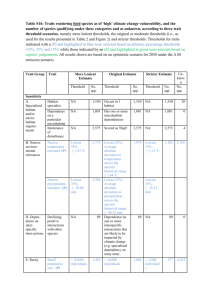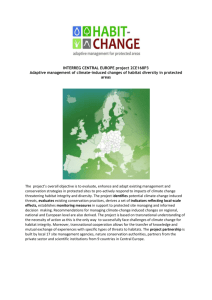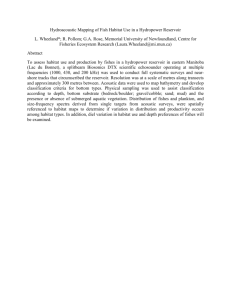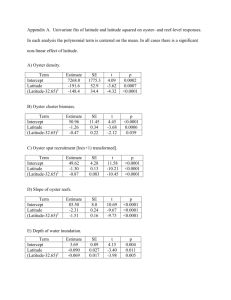Table S17: Traits rendering amphibian species as of `high
advertisement
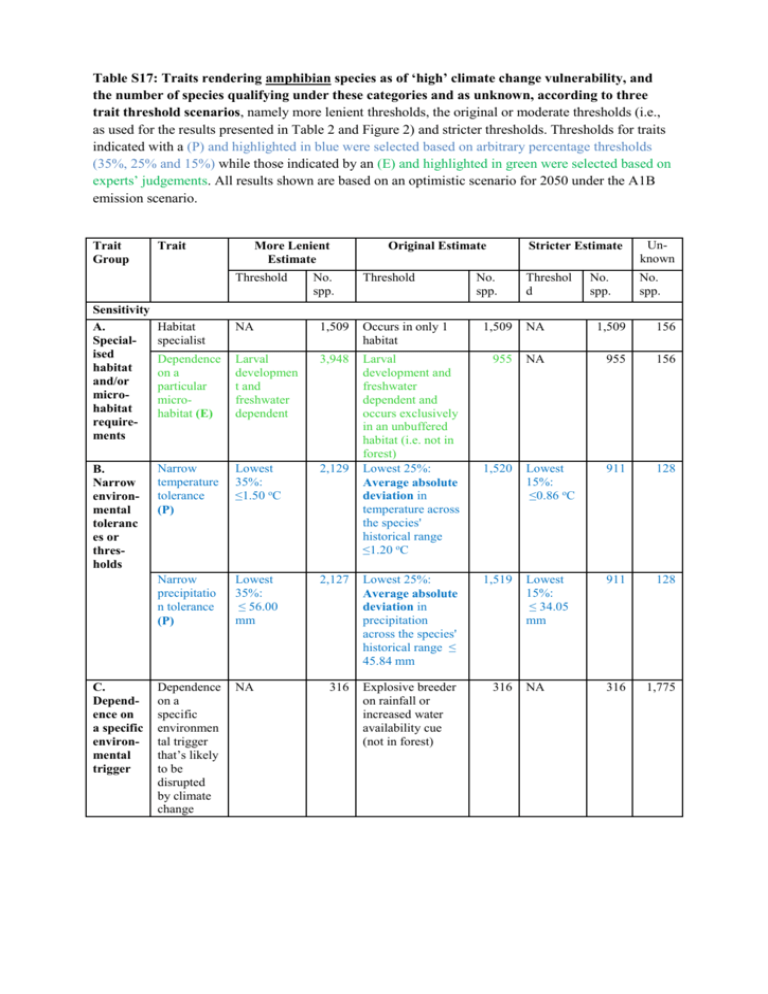
Table S17: Traits rendering amphibian species as of ‘high’ climate change vulnerability, and the number of species qualifying under these categories and as unknown, according to three trait threshold scenarios, namely more lenient thresholds, the original or moderate thresholds (i.e., as used for the results presented in Table 2 and Figure 2) and stricter thresholds. Thresholds for traits indicated with a (P) and highlighted in blue were selected based on arbitrary percentage thresholds (35%, 25% and 15%) while those indicated by an (E) and highlighted in green were selected based on experts’ judgements. All results shown are based on an optimistic scenario for 2050 under the A1B emission scenario. Trait Group Trait More Lenient Estimate Threshold Sensitivity A. Specialised habitat and/or microhabitat requirements B. Narrow environmental toleranc es or thresholds C. Dependence on a specific environmental trigger No. spp. Original Estimate Threshold Habitat specialist NA 1,509 Occurs in only 1 habitat Dependence on a particular microhabitat (E) Larval developmen t and freshwater dependent 3,948 Narrow temperature tolerance (P) Lowest 35%: ≤1.50 oC 2,129 Larval development and freshwater dependent and occurs exclusively in an unbuffered habitat (i.e. not in forest) Lowest 25%: Average absolute deviation in temperature across the species' historical range ≤1.20 oC Narrow precipitatio n tolerance (P) Lowest 35%: ≤ 56.00 mm 2,127 Dependence on a specific environmen tal trigger that’s likely to be disrupted by climate change NA 316 No. spp. Stricter Estimate Unknown Threshol d No. spp. No. spp. 1,509 NA 1,509 156 955 NA 955 156 1,520 Lowest 15%: ≤0.86 oC 911 128 Lowest 25%: Average absolute deviation in precipitation across the species' historical range ≤ 45.84 mm 1,519 Lowest 15%: ≤ 34.05 mm 911 128 Explosive breeder on rainfall or increased water availability cue (not in forest) 316 NA 316 1,775 D. Dependence on interspecific interactions Increasing negative interactions with other species (E) Low adaptive capacity Low A. Poor intrinsic dispersdispersal ability capacity (E) (Chytridiomycosis related decline recorded) or (vulnerable to enigmatic decline) or (likely future infection (in a genus with a recorded infection) 2,719 Has not become established outside its natural range, and not associated with flowing water, and 1,768 (Chytridiomycosis related decline recorded) or (vulnerable to enigmatic decline) or (likely future infection (in a genus with a recorded infection and is freshwater dependent and in subtropical or tropical (forest, shrubland or grassland habitats)) Has not become established outside its natural range, and not associated with flowing water, and range size ≤ 4,000 km2 1,307 1,569 range size ≤ 8,000 km2 B. Poor evolvability Extrinsic barriers to dispersal NA Low reproductive capacity (E) Annual reproductive output ≤ 100 or viviparous 2,081 Occurs in inundation exposed coastal habitats and up to 2 other habitat types 5 Exposure Habitat A. Sea level rise types exposed to sea level inundation (E) 745 Occurs exclusively on mountaintops, small islands, polar edges of land masses and/or polar edges of suitable natural habitat Annual reproductive output <= 50 or viviparous Occurs largely in inundation exposed coastal habitats and up to 1 other habitat type 745 (Chytridiomycosis related decline recorded) or (vulnerabl e to enigmatic decline) 595 0 Has not become established outside its natural range, and not associated with flowing water, and 1,382 113 745 1,559 range size ≤ 2,000 km2 NA 2,073 Annual reproducti ve output ≤ 25 or viviparous 62 3,232 4 Occurs in inundation exposed coastal habitats only 2 156 B. Changes in temperature C. Changes in precipitation Substantial changes in mean temperatur e occur across the species' range (P) Highest 35%: >= 2.4 oC 2,121 Highest 25%: Absolute difference between (mean temperatures across the species' range for all months) from 1975-2050 ≥ 3.0 o C 1,515 Highest 15%: >= 4.1 oC 908 145 Substantial changes in temperatur e variability across the species' range (P) Highest 35%: >= 1.5 oC 2,121 1,515 Highest 15%: >= 2.8 oC 908 145 Substantial changes in mean precipitatio n occur across the species' range (P) Highest 35%: Absolute ratio of change in (mean precipitatio n across the species' range for all months) from 1975 to 2050 >= 0.5 2,121 Highest 25%: Absolute difference between (average absolute deviation in temperature across the species' range for all months) from 1975 to 2050 ≥ 1.9 oC Highest 25%: Absolute ratio of change in (mean precipitation across the species' range for all months) from 1975 to 2050 ≥ 0.6 1,515 908 145 Substantial changes in precipitatio n variability across the species' range (P) Highest 35%: >= 0.5 2,121 Highest 25%: Absolute ratio of change in (average absolute deviation in precipitation across the species' range for all months) from 1975 to 2050 ≥ 0.7 1,515 Highest 15%: Absolute ratio of change in (mean precipitati on across the species' range for all months) from 1975 to 2050 >= 0.8 Highest 15%: >= 1.0 908 145
